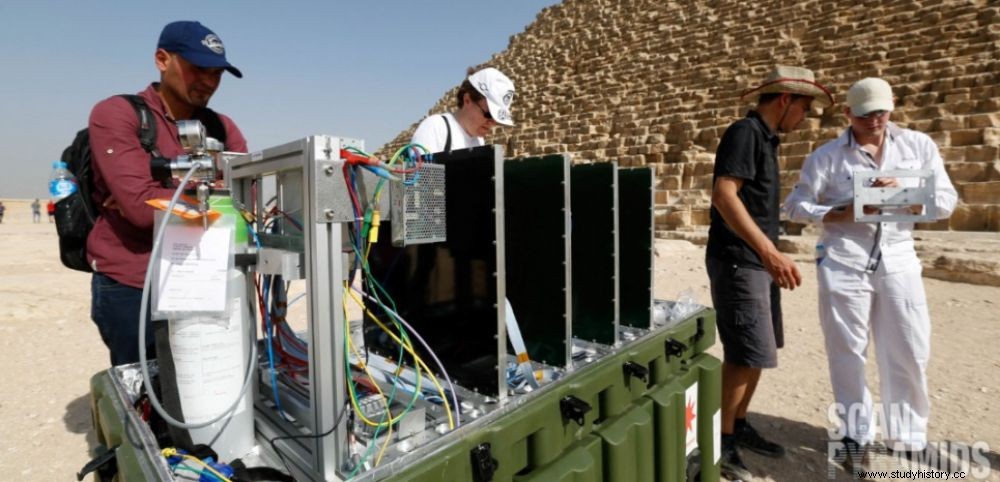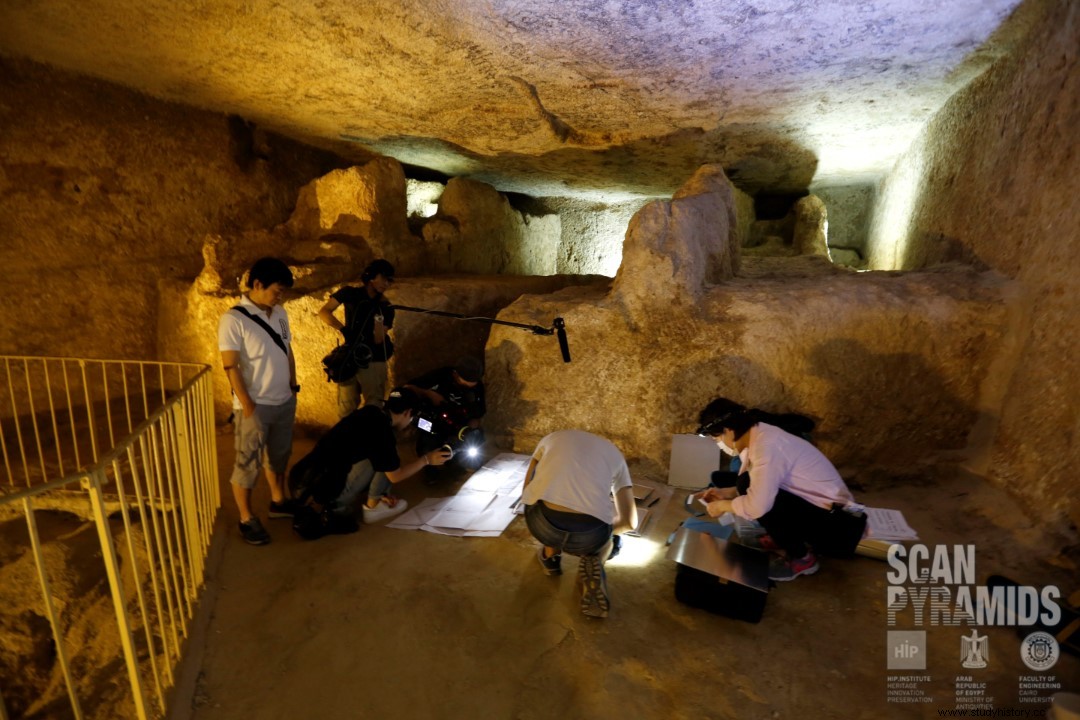 The "Alhazen" muon telescope installed in front of Kheops. It is named after a famous Arab-Muslim mathematician and physicist of medieval times. From left to right:Mostafa Ezzy from the Faculty of Engineering in Cairo, Sébastien Prosecutor, David Attié and Simon Bouteille, from the CEA.
The "Alhazen" muon telescope installed in front of Kheops. It is named after a famous Arab-Muslim mathematician and physicist of medieval times. From left to right:Mostafa Ezzy from the Faculty of Engineering in Cairo, Sébastien Prosecutor, David Attié and Simon Bouteille, from the CEA. Thursday June 2. Tested by a long day at more than forty degrees on the Giza plateau, the team from the CEA (Commissariat for Atomic Energy and Alternative Energies) settles down feverishly in front of a computer. On the screen scroll the first images acquired by the muon telescopes aimed at Kheops. "We only had an hour and a half of recording, says Sébastien Prosecutor, the scientific manager. But little by little we saw the great pyramid appear, its edges take shape. It was really moving. And particularly encouraging for the rest of the campaign!" . The scientist has the feeling of taking part in a "fantastic, unforgettable adventure" . Since April 15, 2016, the CEA has joined the ScanPyramids mission launched in October 2015 by the Cairo Faculty of Engineering and the HIP Institute (Heritage Innovation Preservation) under the authority of the Egyptian Ministry of Antiquities. This mission mobilizes non-invasive high-tech techniques to scan the heart of the great pyramids of the 4th dynasty. Objective of the CEA telescopes:to radiograph Kheops in depth using a gas sensitive to muons, these particles which permanently fall on the earth and are capable of crossing very thick rocks.
It will take us about a month to get sufficiently precise images
Three completely new type of telescopes have been specially developed for the campaign. Well sheltered under air-conditioned tents, two of them are now scanning the east face of Kheops, the last the north face. And obviously it works! "The only problem we had was the transmission of data from the detectors to our lab, continues Sébastien Prosecutor. It is done by simple 3G key. But the connection sometimes drops randomly". The CEA team, which has now moved to its Saclay site, has trained several Egyptian students capable of checking the proper functioning of the instruments and of intervening in the event of a breakdown. This transfer of knowledge is one of the objectives of ScanPyramids. "According to our simulations, it will take us about a month to obtain images that are precise enough to detect possible structural anomalies ", says Sébastien Prosecutor.
In search of cavities
These data will supplement those obtained by another technique developed by the University of Nagoya. Professor Kunihiro Morishima's team has just deployed 80 plastic films coated with a chemical emulsion sensitive to cosmic particles in Kheops. These films have already shown their effectiveness by obtaining a precise X-ray of the rhomboidal pyramid of Dahshur in April 2016. While the CEA telescopes will observe more particularly the edges of the monument from the outside, the plates of the Japanese will X-ray in particular the areas placed above the underground chamber and the Queen's chamber.
Never has a monument been explored with such a battery of technologies! "The results of this major campaign will be shared and submitted to various scientific committees representing disciplines ranging from mechanical engineering to archeology" , explains Mehdi Tayoubi, co-director of the ScanPyramids mission. Among these committees, a group of Egyptologists set up by the Egyptian Ministry of Antiquities, and coordinated by Doctor Zahi Hawass. " The objective of ScanPyramids is to know with certainty whether or not there are cavities in Kheops, concludes Mehdi Tayoubi, not to interpret them. A bit like the medical examiner who conclusively concludes on the causes of death of an Egyptian mummy - poisoning, fracture, or whatever. And then leave it to Egyptologists and historians to speculate about family rivalries, illnesses, to finish writing the story of this mummy."

The Nagoya University team deploys its muon sensors in the underground chamber of Kheops. © ScanPyramids Mission
